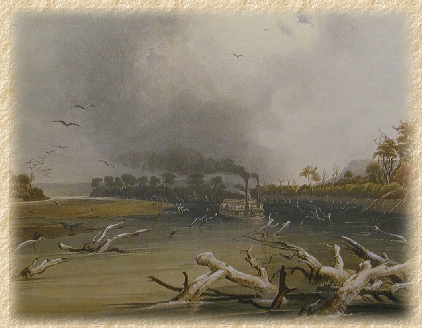Subject Guide

Mountain West
Malachite’s Big Hole
Steamboats:
The use of steamboats, starting in the 1830's, was to be as revolutionary to the fur trade as the introduction of the Rendezvous system was in the 1820's. Shallow draft steamboats could proceed upriver as far as Fort Union at the mouth of the Yellowstone River, and later as far as Fort Benton. Steamboats were able to cover the distance in a small fraction of the time that keelboats or barges could be hauled upriver, and could carry a much larger cargo with fewer men required to do the work. Steamboats would affect the fur trade in two major ways: shipping costs would plummet, and the ability to transport much larger quantities of merchandise deep into the Northern Rockies would allow the American Fur Company to establish and maintain a far flung network of fixed trading posts. These posts would remain open for trade year-round, accepting skins and furs from mountain men and Indians alike.
The Missouri River was not ideally suited for steamboats. Partially or totally submerged
trees or snags, sandbars, and shifting currents made the river treacherous for any
type of boat. If anything, this river was predictably unpredictable. The artist,
George Catlin, while a passenger on the steamboat "Yellow Stone", described the Missouri
River as "a huge deformity of waters." and he said, "There is a terror in its manner..."
The above picture, entitled “Snags on the Missouri” was drawn by Karl Bodmer in
1833.
totally submerged
trees or snags, sandbars, and shifting currents made the river treacherous for any
type of boat. If anything, this river was predictably unpredictable. The artist,
George Catlin, while a passenger on the steamboat "Yellow Stone", described the Missouri
River as "a huge deformity of waters." and he said, "There is a terror in its manner..."
The above picture, entitled “Snags on the Missouri” was drawn by Karl Bodmer in
1833.
The first steamboat to arrive in St. Louis was the S.S. Zebulon M. Pike on July 27, 1817. This was a small steamboat, and its underpowered engine needed help from old-fashioned poles in the hands of cordellers before it could tie up at the docks. Two months later a second steamboat would arrive, the S.S. Constitution. The following spring, the S.S. Independence would fight its way up the more challenging Missouri River as far as Franklin, about half-way across the soon-to-be state of Missouri. Next the S.S. Western Engineer, carrying the military/exploration party of Major Stephen Long, would go up the Missouri as far as Council Bluffs.
The S.S Yellow Stone was the first steamboat acquired by the American Fur Company in 1831. Although it never performed entirely up to expectations, a second steamboat, the S.S. Assiniboine, was put into service by the company in 1833. Delivery of the S.S. Assiniboine was delayed due to a cholera epidemic which was sweeping the continent at that time.
After obtaining the Yellow Stone and Assiniboine, the American Fur Company regularly contracted for additional steamboats. The typical lifespan of steamboats on the powerful and dangerous Missouri River was short, an average of five years by some estimates. The wooden structures of these boats were weakened by sun and water, and sinkings and fires were frequent. The Assiniboine provides an example of the ending of some of these steamboats.. The boat reached Fort Union on June 26, 1834, however due to low water was unable to return downriver. An early freeze forced it to remain through the winter at the mouth of the Poplar River. During its return to St. Louis, a fire broke out, and the vessel, it's cargo of furs and skins, and the natural history collection of Prince Maximillian were all destroyed.
In spite of the high costs and dangers to the steamboats, their appeal is obvious. In a report that J.P. Cabanné sent as he crossed Missouri by steamboat en-route to Council Bluffs, he states "We are arriving here... 3 days and 3 hours since our departure from St. Louis... We are going like an arrow." Lewis and Clark had taken two and one-half weeks to cover the same distance with keelboats. To a generation which had traveled by pack train or keelboat, average speeds on the down-river trip of up to 21 miles an hour were simply unimaginable.
Transportation charges were similarly impacted. Louis C Hunter, in Steamboats on the Western Rivers estimates that freight charges between New Orleans and Louisville prior to the steamship were about $5.00 per hundred weight. By the mid-1820's with the introduction of the steamship, freight charges had dropped to as low as 20 cents per hundred weight.
There was, however, a dark side to the speed and ease with which the steamboats were able to travel up and down the river. The ships enhanced the transmission of disease along the river. In 1837 a major Small Pox epidemic was spread between Indian villages and tribes along nearly the entire length of the Missouri River by the S.S. St. Peter's. The epidemic might have been limited to a small region had not the ship transported infected individuals far beyond where the infected individuals could have traveled by foot or horseback. The epidemic was ended during the winter of 1837-38, when travel and trade between villages and tribes was greatly restricted. However, by this time the destruction was nearly complete. The late 19th century historian, Chittenden estimated that the toll was 15,000, but in considering the population from which this was taken wrote "...mortality almost without parallel in the history of plagues." Follow this link for a more complete description of the Small Pox epidemic spread by the S.S. St. Peter's.